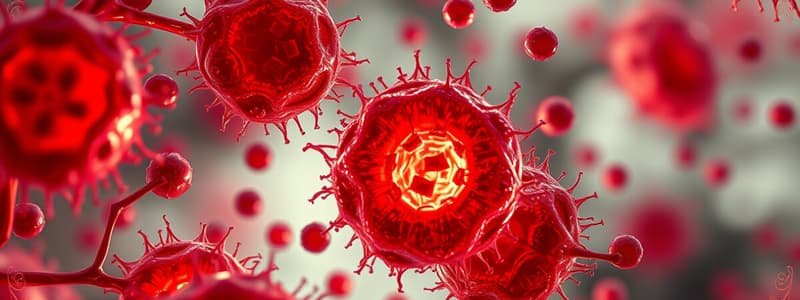Podcast
Questions and Answers
What is one of the conditions that can lead to an increase in eosinophils?
What is one of the conditions that can lead to an increase in eosinophils?
- Bacterial infections
- Bone marrow disorders
- Viral infections
- Allergic disorders (correct)
Which of the following is NOT associated with an increase in eosinophils?
Which of the following is NOT associated with an increase in eosinophils?
- Chronic bronchitis (correct)
- Allergic disorders
- Inflammation of the skin
- Parasite infections
Eosinophils can increase in response to which of the following?
Eosinophils can increase in response to which of the following?
- Inflammation of the skin (correct)
- High blood pressure
- Dehydration
- Stress
What type of infections are eosinophils particularly associated with?
What type of infections are eosinophils particularly associated with?
Which of the following best describes eosinophils' role in the immune response?
Which of the following best describes eosinophils' role in the immune response?
What is the effect of moving the slide faster during the spread process?
What is the effect of moving the slide faster during the spread process?
At what angle should the slide be placed for optimal blood spreading?
At what angle should the slide be placed for optimal blood spreading?
How long should the slide be allowed to dry before applying methanol?
How long should the slide be allowed to dry before applying methanol?
What happens to the smear if the slide is moved at a slower pace?
What happens to the smear if the slide is moved at a slower pace?
What variable can also affect the results of the slide preparation?
What variable can also affect the results of the slide preparation?
What substance found in granules acts as a potent vasodilator?
What substance found in granules acts as a potent vasodilator?
Which granule component functions as an anticoagulant?
Which granule component functions as an anticoagulant?
What can cause an increase in Monocyte (F) levels?
What can cause an increase in Monocyte (F) levels?
Which of the following statements is true regarding Monocyte (F) levels?
Which of the following statements is true regarding Monocyte (F) levels?
What characteristic color do basophils have when stained with a basic dye?
What characteristic color do basophils have when stained with a basic dye?
What is the relationship in size between neutrophils and eosinophils?
What is the relationship in size between neutrophils and eosinophils?
In what situations would you expect Monocyte (F) levels to decrease?
In what situations would you expect Monocyte (F) levels to decrease?
How do the large granules in basophils affect visibility of the nucleus?
How do the large granules in basophils affect visibility of the nucleus?
What type of disorders can increase Monocyte (F) levels?
What type of disorders can increase Monocyte (F) levels?
Which of these is NOT a cause of increased Monocyte (F) levels?
Which of these is NOT a cause of increased Monocyte (F) levels?
What is the predominant type of granulocyte in the blood?
What is the predominant type of granulocyte in the blood?
How does the size of neutrophils compare to red blood cells?
How does the size of neutrophils compare to red blood cells?
What characteristic features neutrophils structurally?
What characteristic features neutrophils structurally?
Which statement best describes the abundance of neutrophils?
Which statement best describes the abundance of neutrophils?
What type of nucleus do neutrophils possess?
What type of nucleus do neutrophils possess?
Flashcards are hidden until you start studying
Study Notes
Eosinophils and Monocytes
- Eosinophils increase in response to allergic disorders, skin inflammation, and parasitic infections.
- Monocyte levels rise during all types of infections and inflammatory disorders.
Slide Preparation Techniques
- For blood smears, hold the slide at a 45-degree angle.
- Move the slide rapidly while applying consistent pressure to create an even smear.
- Allow the slide to dry before applying methanol for fixation, leaving it for 3 to 5 minutes.
- Faster movement results in longer and thinner slides, while slower movement leads to shorter and thicker slides.
Neutrophils
- Represent 60-40% of the majority of granular (polymorphonuclear) cells.
- Slightly larger than red blood cells with a medium size.
- Contain granules rich in histamine (a potent vasodilator) and heparin (an anticoagulant).
Basophils
- Comprise a minimal percentage (1-0%) of white blood cells.
- Associated with allergic reactions and inflammatory responses.
Eosinophils and Neutrophils Characteristics
- Eosinophils and neutrophils are similar in size, falling between small and medium dimensions.
- Eosinophils have abundant granules that stain with basic dyes, appearing blue-black, which can obscure the nucleus due to granule density.
Studying That Suits You
Use AI to generate personalized quizzes and flashcards to suit your learning preferences.




